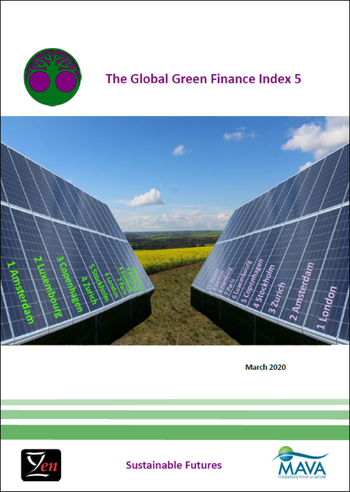Authors
Mike Wardle, Professor Michael Mainelli & Simon Mills
Published by
Long Finance & Financial Centre Futures (March 2020), 96 pages.
Share on social media:



You might also be interested in:
The Global Green Finance Index 5 - Supplement "Green Finance In China"
The fifth edition of the Global Green Finance Index (GGFI 5) was published on 24 March 2020. GGFI 5 provides evaluations of the depth and quality of the green finance offerings of 67 major financial centres around the world. The GGFI serves as a valuable reference into the development of green finance for policy and investment decision-makers.
The GGFI has been developed jointly by Z/Yen, as part of its Long Finance Initiative. We are grateful to the MAVA Foundation for its sponsorship of this work.
The GGFI is updated and published every March and September. 120 financial centres were researched for GGFI 5 of which 67 now feature in the index. The GGFI is compiled using 135 instrumental factors. These quantitative measures are provided by third parties including the World Bank, the Economist Intelligence Unit, the OECD and the United Nations.
The instrumental factors are combined with financial centre assessments provided by respondents to the GGFI online questionnaire. GGFI 5 uses 4,290 assessments from 717 respondents.
The Results Of GGFI 5 Include:
- There is growing confidence in the development of green finance across all regions. Ratings of green finance rose in almost all centres for both depth and quality. All centres received a higher rating for depth than in GGFI 4; and all but five centres received a higher rating in quality.
- Western Europe continues to lead the world’s centres in green finance depth and quality, taking nine of the top ten places in depth and the top 12 places in quality. This reflects the continuing work being undertaken by European financial institutions, central banks, regulators, and the European Union to embed sustainability in their regulatory work.
- The Asia/Pacific region has again fallen back slightly in this edition.
- Amsterdam retained its leading position in the depth index, with Luxembourg still in second place.
- London retained its position as first in the quality index, albeit with a smaller margin than before, with Amsterdam only 6 rating points behind. The leading centres in Western Europe are catching up with London’s ratings for quality.
- Several centres moved more than five places in the indices. Vienna is up 16 places inthe depth index and nine in the quality index. Brussels, Malta, and Cayman Islands are also up more than five places for depth. Guangzhou, Guernsey, and Kuala Lumpur rose more than five places for quality.
Leading Centres
- On depth, the leading nine centres all stayed in the top group, with some minor adjustments in placing. Vienna and Geneva moved into the top ten, on equal ratings. Vancouver dropped from 10th to 17th place.
- On quality, Vienna moved into the top ten and Geneva regained its lead over Brussels to take it into 9th place. Munich has fallen to 11th position. London’s lead in the quality index has reduced from 52 points in GGFI 1 to 6 in GGFI 5, with Amsterdam and Zürich both able to overtake its rating in the next six months.
- Narrow margins continue to separate centres at top of the tables. Among the top ten centres the spread of ratings is 44 out of 1,000 for depth (47 in GGFI 4) and also44 for quality (53 in GGFI 4).
Western Europe
- Western Europe continues to improve its ratings across depth and quality, with all centres receiving improved ratings for both depth and quality.
- Vienna rose 16 places for depth and nine places for quality to enter the top ten on both measures.
- Hamburg fell back slightly on both measures, while Geneva gained ground.
- Hamburg, Munich, Edinburgh, and Lichtenstein fell in the rankings for both depth and quality.
- Oslo entered the index for the first time, ranking 12th for depth and 13th for quality.
North America
- Montréal again took first place in the region for depth, retaining at ninth position overall, but fell six places to 19th in the quality measure. San Francisco was again the leading centre for quality in North America, although it dropped two places overall to 13th. It increased its ranking by one place to 16th in the depth index.
- Vancouver, Boston, and Calgary fell in the rankings for both depth and quality, while Los Angeles improved its position on both measures.
- Canadian centres continue to outperform the USA both in depth and quality.
Asia/Pacific
- Asia/Pacific centres overall fell back in the rankings for both depth and quality, even though ratings improved overall, meaning that other centres improved their performance at a faster rate.
- Sydney has taken the lead in the region in both depth and quality, with Beijing second for depth and Singapore second for quality.
- Shanghai, Guangzhou, and Melbourne fell more than five ranking places since GGFI 4 for depth. For quality, Guangzhou improved its ranking place 13 places, and Kuala Lumpur was up six places, while Melbourne dropped 13 places.
Middle East & Africa
- Casablanca maintained its position as the leading centre in the region, although its overall ranking dropped as Western European centres continued to move forwards. Tel Aviv is in second place in the region on both measures.
- Centres in the region generally lost ground in the quality index.
- Doha entered the GGFI for the first time.
Latin America & The Caribbean
- São Paulo retained its leading position in the region, although its rank dropped slightly in both depth and quality as new centres entered the index. Cayman Islands took second place in the region for depth and quality
- Rio de Janeiro and Bermuda fell in the rankings for both depth and quality.
Eastern Europe & Central Asia
- Prague continued to lead the region, and rose eight places to 32nd for depth, while falling ten places to 32nd for quality.
- Warsaw and Moscow fell in both the depth and quality rankings.




